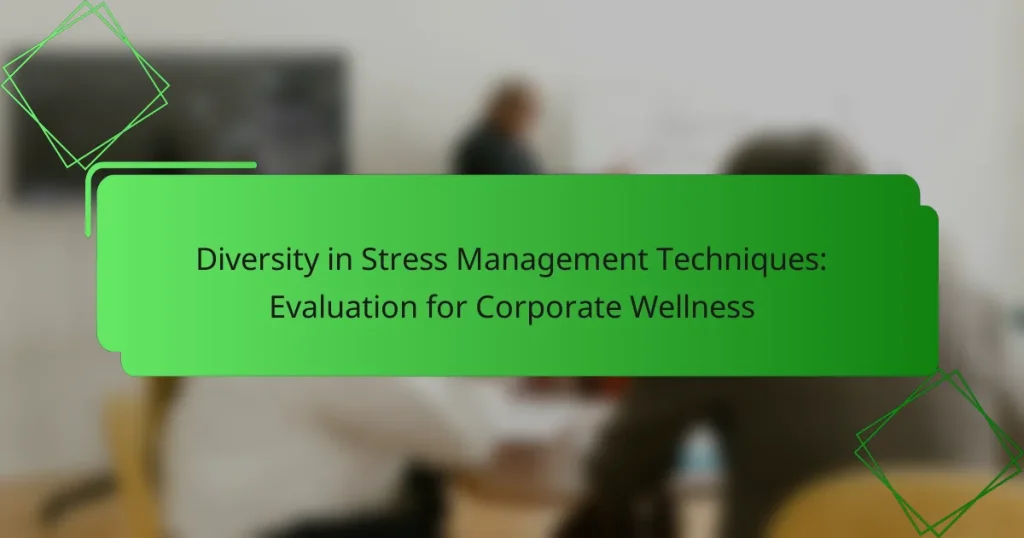In today’s corporate landscape, effective stress management techniques are essential for promoting employee well-being and enhancing productivity. By evaluating diverse approaches tailored to individual needs, companies can create a healthier work environment that fosters job satisfaction and resilience. Implementing these strategies not only supports mental health but also contributes to a more positive and engaged workforce.
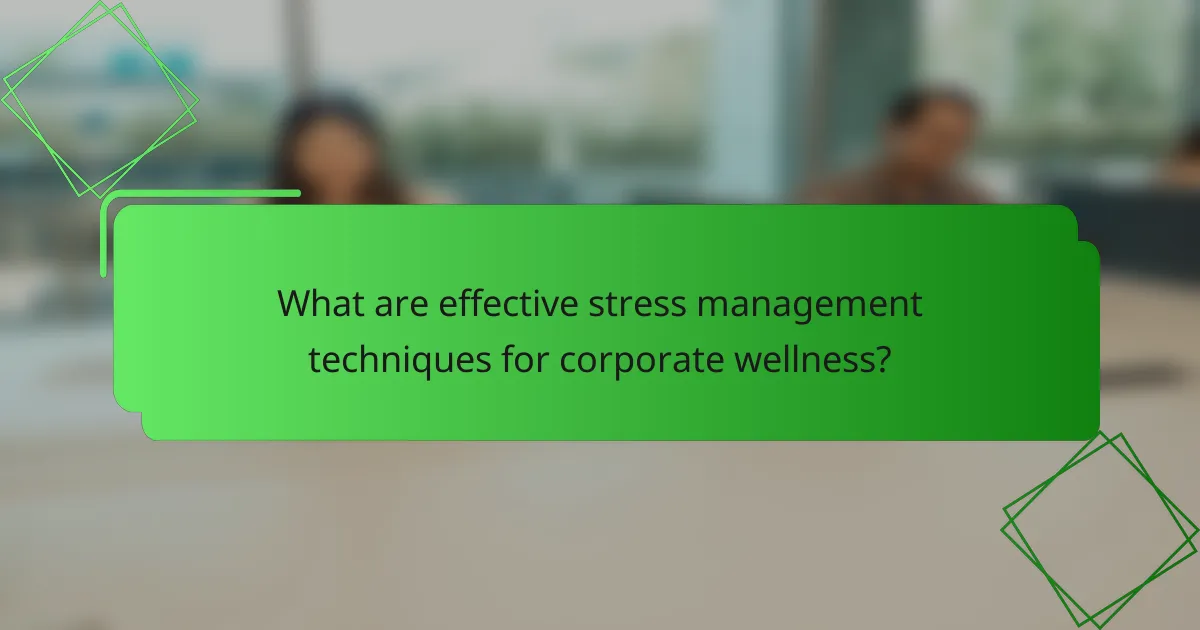
What are effective stress management techniques for corporate wellness?
Effective stress management techniques for corporate wellness include a variety of approaches that promote mental well-being and productivity. These methods can help employees manage stress levels, leading to a healthier work environment and improved job satisfaction.
Mindfulness meditation
Mindfulness meditation involves focusing on the present moment to reduce stress and enhance emotional regulation. Employees can practice mindfulness through guided sessions or apps, often requiring just a few minutes each day to see benefits.
To implement mindfulness in the workplace, companies can offer workshops or create quiet spaces for meditation. Encouraging regular practice can lead to increased focus and reduced anxiety among staff.
Physical exercise programs
Physical exercise programs are effective for stress relief and overall health. Regular physical activity can reduce anxiety and improve mood, making it a vital component of corporate wellness initiatives.
Companies can promote physical fitness by offering gym memberships, organizing group workouts, or providing on-site fitness classes. Even short sessions of 20-30 minutes a few times a week can significantly enhance employee well-being.
Time management workshops
Time management workshops equip employees with skills to prioritize tasks and manage workloads effectively. These workshops can help reduce feelings of overwhelm and improve productivity.
Employers should focus on practical techniques, such as the Pomodoro Technique or Eisenhower Matrix, to help employees organize their time. Regular training sessions can foster a culture of efficiency and reduce stress related to deadlines.
Employee assistance programs
Employee assistance programs (EAPs) provide confidential support for personal and work-related issues, including stress management. These programs often include counseling services, workshops, and resources for mental health support.
Employers should promote EAPs actively to ensure employees are aware of the available resources. Offering a range of services can help address diverse employee needs and foster a supportive workplace culture.
Flexible work arrangements
Flexible work arrangements, such as remote work or adjustable hours, can significantly reduce stress by allowing employees to balance personal and professional responsibilities. This flexibility can lead to improved job satisfaction and retention rates.
To implement flexible arrangements, companies should assess employee needs and preferences. Providing options for part-time work or telecommuting can help create a more adaptable work environment, ultimately benefiting both employees and the organization.
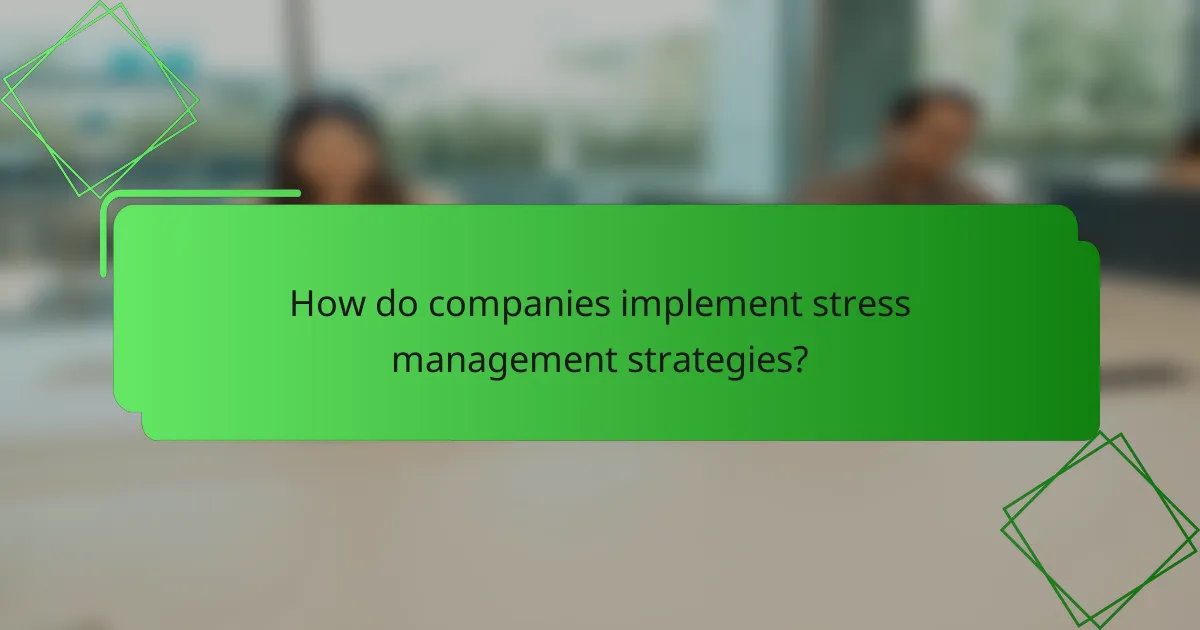
How do companies implement stress management strategies?
Companies implement stress management strategies by assessing employee needs and creating tailored programs. This often involves gathering feedback, forming dedicated wellness teams, and leveraging technology to support mental health initiatives.
Conducting employee surveys
Conducting employee surveys is a crucial first step in identifying stressors within the workplace. Surveys can cover topics such as workload, work-life balance, and available resources, helping companies understand employee perspectives. Regularly scheduled surveys, perhaps quarterly, can track changes over time and inform adjustments to wellness programs.
To maximize participation, ensure anonymity and emphasize the importance of honest feedback. Consider using a mix of quantitative questions and open-ended responses to capture a comprehensive view of employee sentiments.
Creating wellness committees
Creating wellness committees allows companies to take a proactive approach to stress management. These committees typically consist of employees from various departments who collaborate to develop and implement wellness initiatives. By involving employees in the decision-making process, companies can ensure that programs are relevant and effective.
Wellness committees can organize activities such as stress relief workshops, mindfulness sessions, and fitness challenges. Establishing clear goals and regular meetings can help maintain momentum and engagement within the committee.
Integrating technology solutions
Integrating technology solutions can enhance stress management efforts by providing accessible resources for employees. Mobile apps and online platforms can offer meditation guides, stress tracking tools, and virtual counseling sessions. These solutions can cater to diverse employee preferences and schedules, making it easier for individuals to seek help when needed.
When selecting technology solutions, consider user-friendliness and integration with existing systems. Offering training sessions on how to use these tools can further encourage employee participation and utilization of available resources.

What are the benefits of diverse stress management techniques?
Diverse stress management techniques offer numerous benefits, including improved mental health, enhanced productivity, and a more positive workplace environment. By incorporating a variety of approaches, organizations can cater to different employee needs, leading to a more effective overall strategy for stress reduction.
Improved employee productivity
Diverse stress management techniques can significantly boost employee productivity. When employees have access to various methods, such as mindfulness practices, physical activities, or flexible work arrangements, they can choose what works best for them. This personalized approach often leads to higher engagement and output.
For example, companies that implement yoga sessions or meditation breaks report noticeable increases in focus and efficiency. Encouraging employees to take short breaks for physical activity can also enhance cognitive function, resulting in better performance on tasks.
Enhanced workplace morale
A variety of stress management techniques can lead to enhanced workplace morale. When employees feel supported in managing their stress, they are more likely to have a positive outlook on their job and the organization. This support fosters a culture of well-being and collaboration.
Implementing initiatives like team-building exercises or wellness challenges can create a sense of community among employees. When individuals see their colleagues participating in stress relief activities, it encourages them to join in, further boosting morale.
Reduced absenteeism
Diverse stress management techniques can contribute to reduced absenteeism in the workplace. When employees have effective tools to manage their stress, they are less likely to experience burnout or health issues that lead to time off. This can result in significant cost savings for organizations.
For instance, companies that offer mental health days or access to counseling services often see a decline in unplanned absences. By promoting a healthy work-life balance and providing resources, organizations can help employees maintain their well-being and attendance.
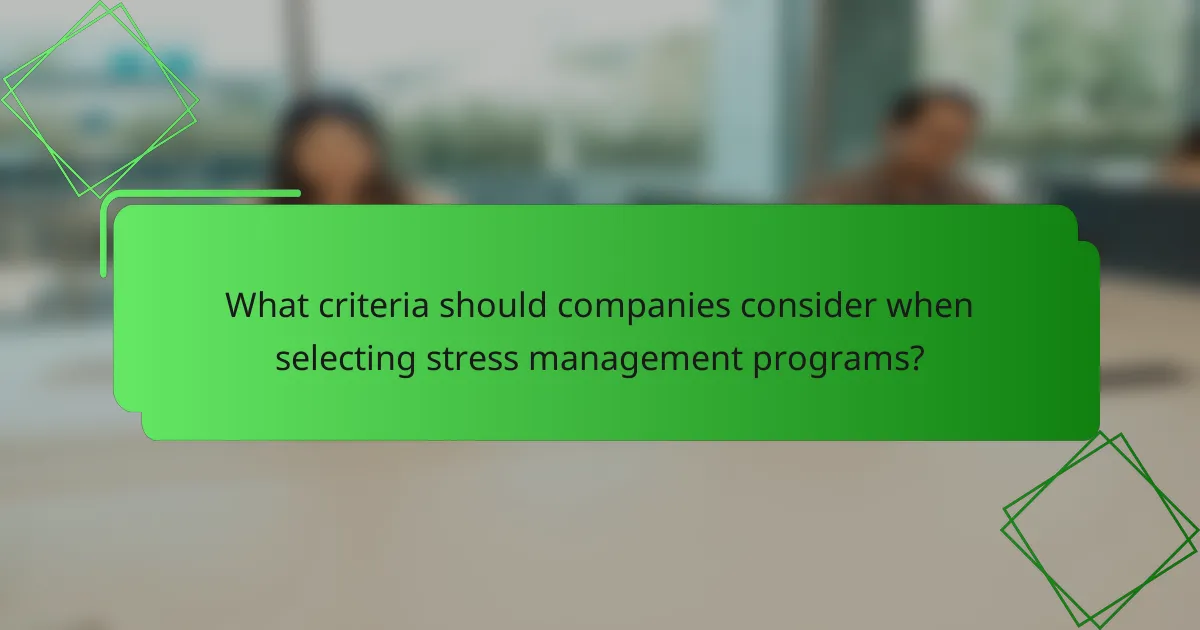
What criteria should companies consider when selecting stress management programs?
Companies should consider employee demographics, program accessibility, and cost-effectiveness when selecting stress management programs. These criteria ensure that the programs are tailored to the workforce’s needs, easily accessible, and financially viable.
Employee demographics
Understanding employee demographics is crucial for selecting effective stress management programs. Factors such as age, gender, cultural background, and job roles can influence how individuals respond to stress and which techniques resonate with them. For instance, younger employees may prefer digital solutions like apps, while older employees might benefit more from in-person workshops.
Conducting surveys or focus groups can help identify the specific needs and preferences of the workforce. This tailored approach increases engagement and the likelihood of program success.
Program accessibility
Accessibility is key to ensuring that all employees can benefit from stress management programs. Companies should evaluate whether programs are available during work hours, offered in various formats (online and in-person), and inclusive of different languages or cultural contexts. Programs that are easily accessible are more likely to see higher participation rates.
Additionally, consider the technological capabilities of the workforce. For example, if many employees work remotely, online resources and virtual sessions may be necessary to reach them effectively.
Cost-effectiveness
Cost-effectiveness is an essential criterion for selecting stress management programs. Companies should assess the overall budget for wellness initiatives and compare the costs of different programs against their expected benefits. This includes considering both direct costs, such as program fees, and indirect costs, like potential productivity gains from reduced employee stress.
To maximize cost-effectiveness, companies can explore options like group discounts or partnerships with local wellness providers. Regularly reviewing program outcomes can also help ensure that investments yield positive returns over time.
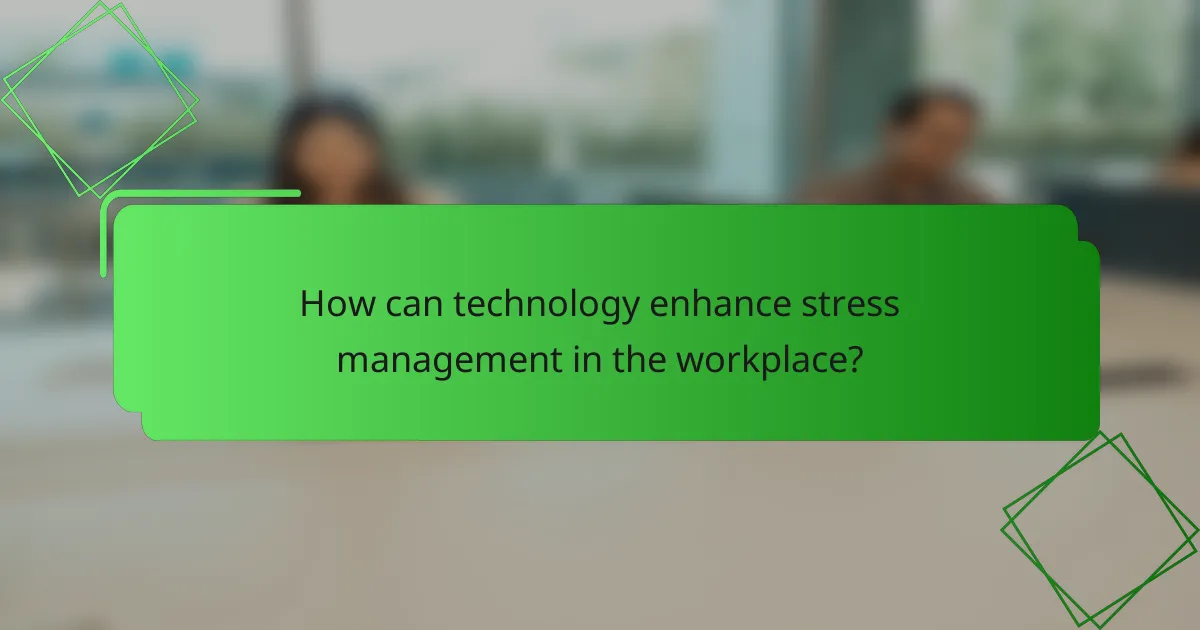
How can technology enhance stress management in the workplace?
Technology can significantly enhance stress management in the workplace by providing accessible tools and resources that cater to diverse employee needs. These innovations facilitate personalized approaches to stress relief, making it easier for employees to engage in wellness practices that suit their individual preferences and lifestyles.
Mobile wellness apps
Mobile wellness apps offer a convenient way for employees to manage stress on-the-go. These applications often include features such as guided meditations, breathing exercises, and mood tracking, allowing users to tailor their stress management strategies to their daily routines.
When selecting a mobile wellness app, consider options that provide a variety of techniques and allow for customization. Popular apps may offer free trials, enabling users to explore different functionalities before committing to a subscription.
Virtual therapy sessions
Virtual therapy sessions provide employees with access to mental health professionals without the need for in-person visits. This flexibility can reduce barriers to seeking help, such as time constraints or geographic limitations.
Employers should consider partnering with telehealth platforms that offer a range of services, including individual therapy, group sessions, and workshops. It’s essential to ensure that these services comply with local regulations and insurance coverage to maximize employee participation.
Online stress assessment tools
Online stress assessment tools help employees identify their stress levels and potential triggers through questionnaires and self-assessments. These tools can provide valuable insights, enabling individuals to take proactive steps toward managing their stress.
Employers can implement these tools as part of a broader wellness program, encouraging employees to regularly assess their stress and seek appropriate resources. It’s beneficial to follow up with personalized recommendations based on assessment results to enhance effectiveness.
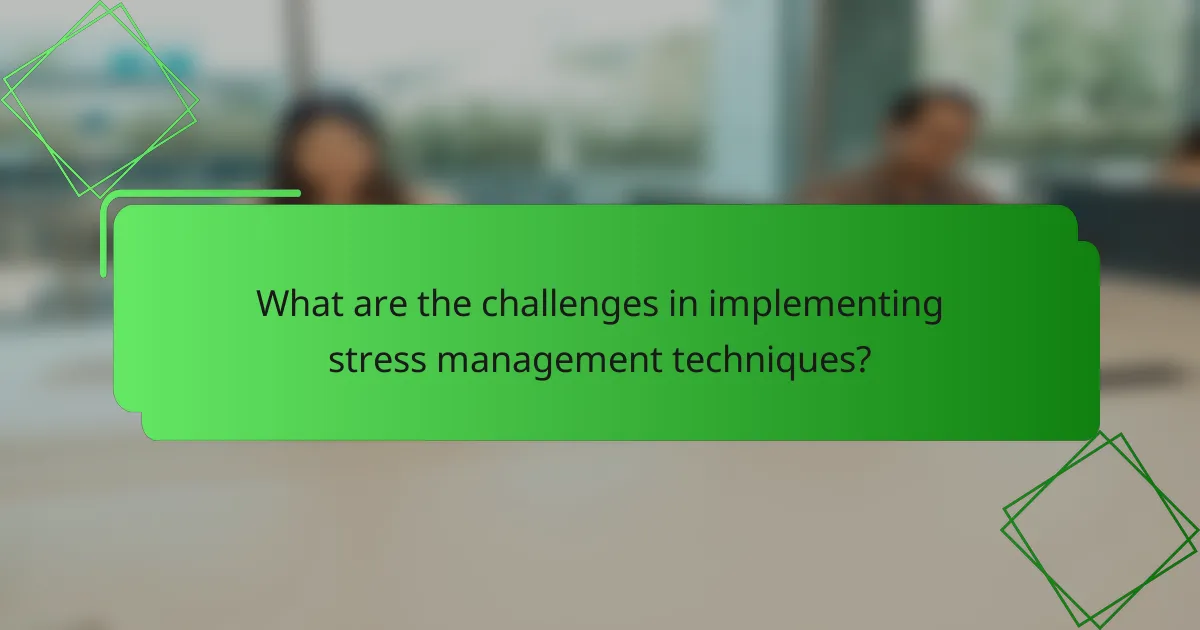
What are the challenges in implementing stress management techniques?
Implementing stress management techniques in corporate settings can be challenging due to various factors such as employee resistance, lack of resources, and insufficient training. Organizations often struggle to create a culture that prioritizes mental well-being, which can hinder the effectiveness of these techniques.
Employee Resistance
Employee resistance to stress management programs can stem from skepticism about their effectiveness or a belief that such initiatives are unnecessary. To address this, companies should involve employees in the planning process and clearly communicate the benefits of stress management techniques.
Offering incentives for participation, such as wellness points or recognition, can also encourage engagement. Providing testimonials from peers who have benefited from these programs can further reduce resistance.
Lack of Resources
Many organizations face a lack of resources, including budget constraints and insufficient staff to implement stress management initiatives effectively. To overcome this, companies can explore low-cost options such as online workshops or partnerships with local wellness providers.
Additionally, leveraging existing resources, such as employee assistance programs (EAPs), can maximize impact without significant financial investment. Prioritizing initiatives that require minimal resources, like mindfulness sessions, can also be effective.
Insufficient Training
Insufficient training for managers and employees on how to utilize stress management techniques can lead to ineffective implementation. Providing comprehensive training sessions that cover various techniques, such as mindfulness, time management, and relaxation strategies, is essential.
Regular follow-up sessions and refresher courses can help maintain skills and reinforce the importance of stress management. Encouraging a culture of continuous learning can empower employees to adopt these techniques more effectively.
